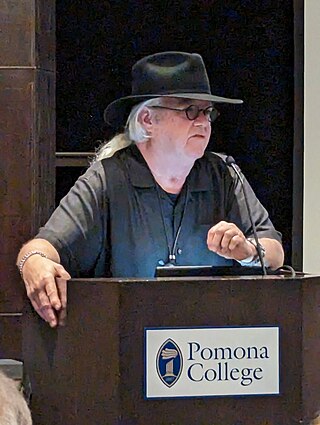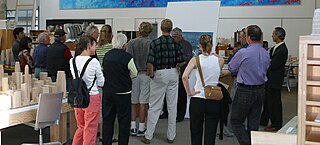Related Research Articles
Tim Hawkinson is an American artist who mostly works as a sculptor.
The Biennale Internazionale Dell’Arte Contemporanea, also known as the Florence Biennale is an art exhibition held in Florence, Italy. Since 1997 it has been held every two years in the exhibition spaces of the Fortezza da Basso, Florence.

John Thomas Spike is an American art historian, curator, and author, specializing in the Italian Renaissance and Baroque periods. He is also a contemporary art critic and past director of the Florence Biennale.

John Harvey McCracken was a minimalist artist. He lived and worked in Los Angeles, Santa Fe, New Mexico, and New York.

Jack Zajac is a Californian West Coast artist who has been concerned with the “Romantic Surrealist tradition”.

Kenneth Price was an American artist who predominantly created ceramic sculpture. He studied at the Chouinard Art Institute and Otis Art Institute in Los Angeles, before receiving his BFA degree from the University of Southern California in 1956. He continued his studies at Chouinard Art Institute in 1957 and received an MFA degree from New York State College of Ceramics at Alfred University in 1959. Kenneth Price studied ceramics with Peter Voulkos at Otis and was awarded a Tamarind Fellowship.

Peter Shelton is a contemporary American sculptor born in 1951 in Troy, Ohio.

De Wain Valentine was an American minimalist sculptor who was born in Fort Collins, Colorado. Often associated with the Light and Space movement in the 1960s, he is best known for his minimalist sculptures of translucent glass, fiberglass and cast polyester resin having slick surfaces suggestive of machine made objects. He lived and worked in Gardena, California.
Ed Moses was an American artist based in Los Angeles and a central figure of postwar West Coast art.
Elizabeth H. Lidow was an American artist.

Light and Space denotes a loosely affiliated art movement related to op art, minimalism and geometric abstraction originating in Southern California in the 1960s and influenced by John McLaughlin. It is characterized by a focus on perceptual phenomena, such as light, volume and scale, and the use of materials such as glass, neon, fluorescent lights, resin and cast acrylic, often forming installations conditioned by the work's surroundings. Whether by directing the flow of natural light, embedding artificial light within objects or architecture, or by playing with light through the use of transparent, translucent or reflective materials, Light and Space artists make the spectator's experience of light and other sensory phenomena under specific conditions the focus of their work. From the movement's inception, artists were incorporating into their work the latest technologies of the Southern California-based engineering and aerospace industries to develop sensuous, light-filled objects. Turrell, who has spread the movement worldwide, summed up its philosophy in saying, "We eat light, drink it in through our skins."

Peter Alexander was an American artist who was part of the Light and Space artistic movement in southern California in the 1960s. He is notable for his resin sculptures from the 1960s and 1970s.
Lita Albuquerque is an American installation, environmental artist, painter and sculptor. She is a part of the core faculty in the Graduate Fine Art Program at Art Center College of Design.
Glenn Akira Kaino is an American conceptual artist based in Los Angeles.
Helen Pashgian is an American visual artist who lives and works in Pasadena, California. She is a primary member of the Light and Space art movement of the 1960s, but her role has been historically under-recognized.
Mary Corse is an American artist who lives and works in Topanga, California. Fascinated with perceptual phenomena and the idea that light itself can serve as both subject and material in art, Corse's practice can be seen as existing at an crossroads between American Abstract Expressionism and American Minimalism. She is often associated with the male-dominated Light and Space art movement of the 1960s, although her role has only been fully recognized in recent years. She is best known for her experimentation with radiant surfaces in minimalist painting, incorporating materials that reflect light such as glass microspheres. Corse initially attended University of California, Santa Barbara starting in 1963. She later moved on to study at Chouinard Art Institute, earning her B.F.A. in 1968.
Roger Allen Kotoske (1933–2010) was an American sculptor, painter and educator.
Ines Reingold-Tali, known by her stage names Inéz, Inèz or Inez, is an Estonian new media artist, musician, composer and writer on sound art, noise, electronic music, glitch and digital culture. She lives and works in Finland. Since the mid-1990s she has belonged to a new generation of composers in Finland interested in experimental interdisciplinary art projects and electronic music. Her repertoire includes electroacoustic chamber music, experimental, electronic and film music. She has been engaged in commissioned projects in the fields of electroacoustic, contemporary chamber music and experimental music, in different audiovisual art projects, video art, poetry, performance, theater, short films and radio-art. Her compositions have been broadcast internationally on various radio stations and television channels in many European countries, Australia, Canada and the USA. Her works have been published on solo-albums and international compilations by various labels, incl. K-tel International, FG Music/Naxos, YOCOMA, YAP and Charm of Sound. She has been nominated to participate in various international festivals, exhibitions and conferences, Florence Biennale 2007 in Italy, LACDA International Juried Competition Winners Show (award) at the Los Angeles Center for Digital Art in USA 2007, 30e Festival International des Musiques Syntheses 2000 in France and international conferences on musicology, among others.
Marilyn Ann McCoy is an American artist. During her early career she created sculptures in wood and plastic resin. Beginning in the early 1970s, she abandoned sculpture to focus on large-scale drawings in colored pencil. She was a Guggenheim Foundation fellow in 2019.
Ann Ter-Pogossian, was an American oil painter who exhibited in the United States, England, Spain, France, and Italy. Works included landscapes, still lifes, portraits, figures in motion, and commentaries on current events. One review described her work as using "knowledge of the great artistic movements of the past … to re-evaluate and reinterpret familiar themes concerning the problems of figures in movement, perspective and iconography." A common theme in later works is the roles of women in society.
References
- ↑ Frederick John Eversley Fred Eversley.
- ↑ Lewis, Samella (2003). African American Art and Artists (Third ed.). Berkeley and Los Angeles: University of California Press. p. 224. ISBN 978-0-520-23929-6.
- ↑ Jones, Kellie (2011). Now Dig This! Art & Black Los Angeles 1960-1980. Los Angeles: Hammer Museum, UCLA. ISBN 978-3-7913-5136-0.
- 1 2 Henry Ghent, 8 Artistes Afro-Américains. Genève: Musée Rath, 1971: pages 46–51.
- ↑ Jones, Kelly (2011). Now Dig This! Art & Black Los Angeles 1960-1980. Los Angeles: Hammer Museum, UCLA. pp. 21–22. ISBN 978-3-7913-5136-0.
- ↑ "Frederick Eversley". Smithsonian American Art Museum. Retrieved 4 February 2015.
- ↑ "Frederick Eversley»Pacific Standard Time at the Getty". Pacific Standard Time at the Getty. Retrieved 2019-02-17.
- ↑ "Blue Para, (cast polyester resin)". Fred Eversley: Black, White, Gray and Transparent Color. Muscarelle Museum of Art. 2017. Retrieved 20 Jun 2018.
- ↑ "Fred Eversley". Whitney Museum. Retrieved February 9, 2023.